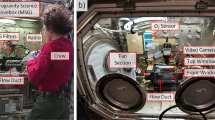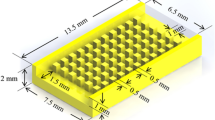Abstract
Recently, high temperature combustion techniques have been extensively adopted to improve thermal efficiency of combustion devices. When the temperature is sufficiently high, fuel pyrolysis may occur and then the flame structure can be affected. Thus, the understanding flame structure at high temperature coupled with fuel pyrolysis is essential to design burners operated in high temperature environments. In this study, propane was heated up to 1100 K using an electric heater, and the characteristics of fuel pyrolysis and its effects on non-premixed jet flames were experimentally investigated at room temperature. Normalized volume flow rates and components were measured regarding the fuel pyrolysis. The normalized volume flow rates of the propane were increased significantly through the pyrolysis process, and they agreed with numerical results based on an ordinary chemical mechanism. Variations of flame height and soot region were compared for the pyrolysis temperature. Conclusively, in spite of the significant growth in the volume flow rate by the propane pyrolysis, flame height was not significantly affected. On the contrary, the soot region was slightly extended by the fuel pyrolysis. This study will help to extend understanding on jet flame characteristics especially at high temperature conditions.
Similar content being viewed by others
References
A. Cavaliere and M. de Joannon, Mild combustion, Prog. Energ. Combust, 30 (4) (2004) 329–366.
C. N. Hinshelwood and P. J. Askey, Homogeneous reactions involving complex molecules, The kinetics of the decomposition of gaseous dimethyl ether, Proceedings of the Royal Society of London, Series A, Containing Papers of a Mathematical and Physical Character (1927) 215–226.
B. L. Crynes and L. F. Albright, Pyrolysis of propane in tubular flow reactors, Kinetics and surface effects, Industrial & Engineering Chemistry Process Design and Development (1969) 25–31.
Z. D. Ziaka, R. G. Minet and T. T. Tsotsis, A high temperature catalytic membrane reactor for propane dehydrogenation, J. Membr. Sci., 77 (2–3) (1993) 221–232.
S. K. Layokun and D. H. Slater, Mechanism and kinetics of propane pyrolysis, Industrial & Engineering Chemistry Process Design and Development, 18 (2) (1979) 232–236.
R. J. Kee et al., CHEMKIN-III: A Fortran chemical kinetics package for the analysis of gas-phase chemical and plasma kinetics (1996).
G. P. Smith et al., GRI-Mech 3.0. (1999).
K. M. Leung, R. P. Lindstedt and W. P. Jones, A simplified reaction mechanism for soot formation in nonpremixed flames, Combust. Flame, 87 (3–4) (1991) 289–305.
P. A. Tesner, T. D. Smegiriova and V. G. Knorre, Kinetics of dispersed carbon formation, Combust. Flame, 17 (2) (1971) 253–260.
S. J. Harris and A. M. Weiner, Determination of the rate constant for soot surface growth, Combust. Sci. Technol., 32 (5–6) (1983) 267–275.
J. H. Kent, A quantitative relathionship between soot yeield and smoke point mearurements, Combust. Flame, 63 (1986) 349–358.
Author information
Authors and Affiliations
Corresponding author
Additional information
Recommended by Associate Editor Jeong Park
Min-Kyu Jeon obtained his B.S. degree in Chemical and Biomolecular Engineering from Pusan Nat. Univ. in 2012. He obtained M.S. degree in Chemical and Biomolecular Engineering from KAIST in 2014. He is a Ph.D. candidate in Department of Mechanical Engineering, KAIST, Daejeon, Korea. His research interests include fuel property control and edge flame.
Moon Soo Cho obtained his B.S. and M.S. degrees in Mechanical Engineering, Chung-Ang University, Seoul, Korea in 2013 and 2015, respectively. His research interests include fuel property control and flame instability in a refractory structure.
Min Jung Lee obtained his B.S., M.S., and Ph.D. degrees in Mechanical Engineering, Chung-Ang University in 2008, 2010 and 2014, respectively. He is working as a researcher in Department of Mechanical Engineering, KAIST, Daejeon, Korea. His research interests include flame structure, flame seed, edge flame, micro combustor, and fire safety.
Nam Il Kim obtained his B.S. degree in Mechanical Engineering from Pusan Nat. Univ. in 1994. He obtained M.S. and Ph.D. degrees in Mechanical Engineering from KAIST in 1996 and 2001, respectively. He is an associate professor in Department of Mechanical Engineering, KAIST, Daejeon, Korea.
Hong Sun Ryou obtained his B.S. and M.S. degrees in Aeronautical Engineering from Seoul Nat. Univ. He obtained Ph.D. degree in Aeronautics from Imperial College, London, UK. He is a professor in School of Mechanical Engineering, Chung-Ang University, Seoul, Korea.
Rights and permissions
About this article
Cite this article
Jeon, MK., Cho, M.S., Lee, M.J. et al. Effects of propane pyrolysis on basic flame structures of non-premixed jet flame. J Mech Sci Technol 29, 4053–4059 (2015). https://doi.org/10.1007/s12206-015-0851-1
Received:
Revised:
Accepted:
Published:
Issue Date:
DOI: https://doi.org/10.1007/s12206-015-0851-1




